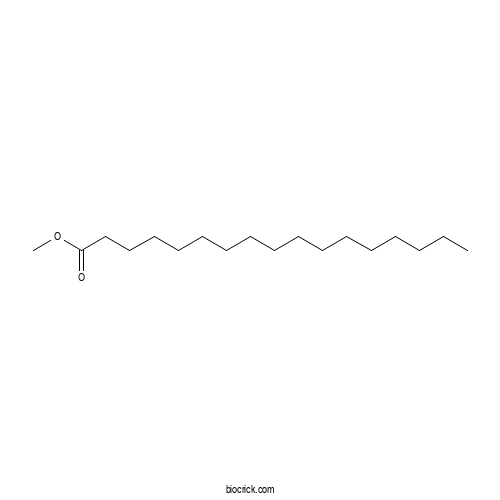Methyl heptadecanoateCAS# 1731-92-6 |

Quality Control & MSDS
3D structure
Package In Stock
Number of papers citing our products

| Cas No. | 1731-92-6 | SDF | Download SDF |
| PubChem ID | 15609.0 | Appearance | Powder |
| Formula | C18H36O2 | M.Wt | 284.48 |
| Type of Compound | Aliphatics | Storage | Desiccate at -20°C |
| Solubility | Soluble in Chloroform,Dichloromethane,Ethyl Acetate,DMSO,Acetone,etc. | ||
| Chemical Name | methyl heptadecanoate | ||
| SMILES | CCCCCCCCCCCCCCCCC(=O)OC | ||
| Standard InChIKey | HUEBIMLTDXKIPR-UHFFFAOYSA-N | ||
| Standard InChI | InChI=1S/C18H36O2/c1-3-4-5-6-7-8-9-10-11-12-13-14-15-16-17-18(19)20-2/h3-17H2,1-2H3 | ||
| General tips | For obtaining a higher solubility , please warm the tube at 37 ℃ and shake it in the ultrasonic bath for a while.Stock solution can be stored below -20℃ for several months. We recommend that you prepare and use the solution on the same day. However, if the test schedule requires, the stock solutions can be prepared in advance, and the stock solution must be sealed and stored below -20℃. In general, the stock solution can be kept for several months. Before use, we recommend that you leave the vial at room temperature for at least an hour before opening it. |
||
| About Packaging | 1. The packaging of the product may be reversed during transportation, cause the high purity compounds to adhere to the neck or cap of the vial.Take the vail out of its packaging and shake gently until the compounds fall to the bottom of the vial. 2. For liquid products, please centrifuge at 500xg to gather the liquid to the bottom of the vial. 3. Try to avoid loss or contamination during the experiment. |
||
| Shipping Condition | Packaging according to customer requirements(5mg, 10mg, 20mg and more). Ship via FedEx, DHL, UPS, EMS or other couriers with RT, or blue ice upon request. | ||

Methyl heptadecanoate Dilution Calculator

Methyl heptadecanoate Molarity Calculator
| 1 mg | 5 mg | 10 mg | 20 mg | 25 mg | |
| 1 mM | 3.5152 mL | 17.5759 mL | 35.1519 mL | 70.3037 mL | 87.8796 mL |
| 5 mM | 0.703 mL | 3.5152 mL | 7.0304 mL | 14.0607 mL | 17.5759 mL |
| 10 mM | 0.3515 mL | 1.7576 mL | 3.5152 mL | 7.0304 mL | 8.788 mL |
| 50 mM | 0.0703 mL | 0.3515 mL | 0.703 mL | 1.4061 mL | 1.7576 mL |
| 100 mM | 0.0352 mL | 0.1758 mL | 0.3515 mL | 0.703 mL | 0.8788 mL |
| * Note: If you are in the process of experiment, it's necessary to make the dilution ratios of the samples. The dilution data above is only for reference. Normally, it's can get a better solubility within lower of Concentrations. | |||||

Calcutta University

University of Minnesota

University of Maryland School of Medicine

University of Illinois at Chicago

The Ohio State University

University of Zurich

Harvard University

Colorado State University

Auburn University

Yale University

Worcester Polytechnic Institute

Washington State University

Stanford University

University of Leipzig

Universidade da Beira Interior

The Institute of Cancer Research

Heidelberg University

University of Amsterdam

University of Auckland

TsingHua University

The University of Michigan

Miami University

DRURY University

Jilin University

Fudan University

Wuhan University

Sun Yat-sen University

Universite de Paris

Deemed University

Auckland University

The University of Tokyo

Korea University
- Heptadecanoic acid
Catalog No.:BCX1374
CAS No.:506-12-7
- Pentadecanoic acid
Catalog No.:BCX1373
CAS No.:1002-84-2
- Methyl tridecanoate
Catalog No.:BCX1372
CAS No.:1731-88-0
- Tridecanoic acid
Catalog No.:BCX1371
CAS No.:638-53-9
- Octadec-11-enoic acid
Catalog No.:BCX1370
CAS No.:693-72-1
- Cis-11-Eicosenoic acid
Catalog No.:BCX1369
CAS No.:5561-99-9
- Elaidic acid methyl ester
Catalog No.:BCX1368
CAS No.:1937-62-8
- Myristoleic acid
Catalog No.:BCX1367
CAS No.:544-64-9
- Ethyl (2E,4Z)-deca-2,4-dienoate
Catalog No.:BCX1366
CAS No.:3025-30-7
- Morroniaglycone
Catalog No.:BCX1365
CAS No.:1644061-02-8
- Crocetindial
Catalog No.:BCX1364
CAS No.:502-70-5
- Gymnoside VII
Catalog No.:BCX1363
CAS No.:899430-07-0
- Nonadecanoic acid
Catalog No.:BCX1376
CAS No.:646-30-0
- Ethyl palmitoleate
Catalog No.:BCX1377
CAS No.:56219-10-4
- Palmitoleic acid
Catalog No.:BCX1378
CAS No.:373-49-9
- Arachidic acid
Catalog No.:BCX1379
CAS No.:506-30-9
- Ethyl Arachidonate
Catalog No.:BCX1380
CAS No.:1808-26-0
- Methyl arachidonate
Catalog No.:BCX1381
CAS No.:2566-89-4
- Ethyl oleate
Catalog No.:BCX1382
CAS No.:111-62-6
- Docosahexaenoic acid ethyl ester
Catalog No.:BCX1383
CAS No.:84494-72-4
- Docosahexaenoic acid methyl ester
Catalog No.:BCX1384
CAS No.:2566-90-7
- Eicosapentaenoic acid ethyl ester
Catalog No.:BCX1385
CAS No.:86227-47-6
- Methyl Eicosapentaenoate
Catalog No.:BCX1386
CAS No.:2734-47-6
- Linoleic acid sodium salt
Catalog No.:BCX1387
CAS No.:822-17-3
Association of faecal volatiles and steroids with behavioural expression during oestrous cycle of sheep (Ovis aries).[Pubmed:36891738]
Reprod Domest Anim. 2023 Jun;58(6):708-716.
This study was investigated to determine the faecal volatiles, steroid hormones and their correlation with behavioural signs during oestrous cycle in sheep (Ovis aries). This experiment was monitored from pro-oestrous to met-oestrous phases for correlation of endocrine dependence biochemical constituents in faeces and blood to detection of oestrous biomarkers. Medroxyprogesterone acetate sponges were used for 8 days to bring uniformity of oestrus in sheep. Faeces were collected during different phases of cycle and subjected to determination of fatty acids, minerals, oestrogens and progesterone analysis. Likewise, blood samples were also obtained for enzymatic and no-enzymatic antioxidants. The results revealed that faecal progesterone and oestrogen levels significantly increased during pro-oestrous and oestrous phase, respectively (p < .05). The blood plasma enzymatic levels showed significant demarcation during the oestrous phase than other periods (p < .05). There were also reported marked variations in volatile fatty acids across different phases of the oestrous cycle. Interestingly, methyl octanoate, methyl cis-10 pentadecenoate and Methyl heptadecanoate volatiles were found to be specific to oestrus period. In addition, methyl hexanoate, methyl palmitoleate and methyl cis-9 oleate were identified in met-oestrus, indicating their possible role to be an oestrous biomarker. It is concluded that the pattern of volatile compounds and faecal steroids, in association with behavioural patterns, could be measured as a non-invasive method of heat detection in sheep.


